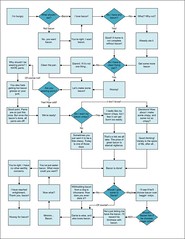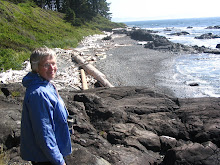 Image by i am indisposed via Flickr
Image by i am indisposed via Flickr
I recently watched a video in which Lawrence Lessig talks about the hybrid economy of copyright and Creative Commons. Lessig is the developer of Creative Commons which was launched in December of 2002. For many products uploaded and licensed under Creative Commons, as long as you attribute the work to its creator, you are welcome to use the work free of charge.
At times, during my years as a teacher, there have been reminders of the importance of abiding by copyright restrictions. The copyright police have even descended upon some schools and scrutinized each use of the photocopier.
When I think about copyright, intellectual property, being a good digital citizen, combined with my cheapskate ways (FREE is my favourite price), I wish I had a copyright flow chart (similar to the bacon flowchart above. Hint: Click on the creator's name to go to Flickr for a larger version of this flow chart.) The flow chart would begin with the type of media or content. As I answer various questions about the product I wish to use, I will follow through on the flow chart until I reach a definitive answer on whether I am abiding by copyright regulations. One of my classmates (Hancox, 2010) suggested the following questions:
- What is the purpose of the original copyrighted material?
- What is the purpose of my own use (teaching, scholarship, criticism, comment etc)?
- Are you crediting the original author of the work?
- How is my purpose for using the copyrighted work different from the author's original purpose?
- What is the nature and amount taken? Was it appropriate considering the nature of the copyrighted work and the use?
- Did the unlicensed use "transform" the material taken from the original copyrighted work by adding value? Is the use of copyrighted material contributing to a unique new creative work, or does it mostly repeat the work for the same intent and value as the original?
- What is the effect of my actions? Does the effect of my use impact the potential market of the original? Will it compete with the original work? How would I feel about this use of the copyright work if I was the author instead?
- Is the project being used only within the school?
Copyright
Butler says that copyright "is a privilege of law, given to owners of tangible works...the owner...[can] reproduce or copy, distribute, publicly perform or display and create derivatives of it" (Butler, 2005, p. 41). Much of the professional literature around copyright has been written outside of Canada. In order to understand Canadian copyright laws, visit the Canadian Copyright Act website. Access is the Canadian Copyright Licensing Agency (website). At their site, they have a section to answer frequently asked questions for elementary and secondary schools in Canada. This agency will assist you with getting the rights to copy certain materials. If you are outside of Canada, Copyright Watch collects copyright regulations from other countries (website).
Teaching about Copyright
- Show this video which is American and oriented towards commercial interests. However, it presents basic information about copyright and issues related to it.
- Temple University has created a webpage that collates a number of resources for teaching about copyright issues.
- Educators could use the Library Copyright Slider with middle years or high school students. Students could use this interactive tool to work with books on the library shelves.
In the United States, there are fair use agreements that allow educators to use copyrighted materials. In Canada, the educational use of copyrighted materials are managed under a concept of fair dealing. To read about both of these concepts, please visit this website. There is an online Fair Use Evaluator. Temple University has developed a pdf which can be printed out and used to determine the fair use of content or media. It would be helpful to have a similar pdf file developed that meets the slightly different Fair Dealing criteria in Canada.
Creative Commons
The motto on the Creative Commons website is: Share, Remix, Reuse - Legally. This site was launched in December of 2002 by Lawrence Lessig. Lessig realized that copyright restrictions (all rights reserved) were more protectionist than many content creators wanted them to be. There was no simple way to signal an artist's willingness to share their content. Lessig created a framework called Creative Commons that content creators may use to signal their ownership wishes. "Creative Commons helps you publish your work online while letting others know exactly what they can and can't do with your work. When you choose a license, we provide you with tools and tutorials that let you add license information to our own site, or to one of several free hosting services that have incorporated Creative Commons." (License your work site)
I believe that as people remix content that is available through Creative Commons, they are being encouraged to use and reuse information. They are making their own connections with content and with their own lives. The reality is that all content is derivative. Years ago, my university professor said that every story stands on the shoulders of another story. This idea comes from a quote attributed to Bernard of Chartres who said "We are like dwarfs standing [or sitting] upon the shoulders of giants, and so able to see more and see farther than the ancients." (On the shoulders of) If Bernard (who wrote this around 1100) could acknowledge that all thought is derivative, who are we to kick away the giants and start from ground level.
Teaching About Creative Commons
- View this Slideshare presentation (What every educator needs to know) to learn about Creative Commons (website)
- Encourage students to use the resources on Joyce Valenza's wiki page of copyright friendly tools (website)
- Have students take digital photos. Upload them to Flickr and license through Creative Commons.
- One issue with using Creative Commons is that it is time consuming to uncover the best resources. Have students work on projects of meta-tagging information and photographs in order to help people access the resources available through Creative Commons. At the Wikimedia Commons there is a request for people to help with the images donated by the Tropenmuseum.
- View this video: Wanna Work Together (Explanation of Creative Commons)
Digital Citizenship
I recently visited some student displays of author studies. I learned a lot about some children's authors. What disturbed me (in light of our copyright discussions this week) was the lack of attribution or referencing for the information shared. There were over fifteen displays with no references listed on any of them. Some information was obviously printed directly from the internet (with the URL location cut off the bottom). Some information was rewritten in the students' own words. However, no books or websites were cited. This displays poor digital citizenship skills. We need to teach students to give credit where credit is due.
Last week I visited a school library in which the grade four students were working on Powerpoint presentations as the culmination of an inquiry learning unit. I was intrigued to hear the teacher-librarian reminding the students to create citations using ISBN numbers. They were using a program called OttoBib which allows you to easily cite your sources. This teacher was helping the students to demonstrate good digital citizenship skills.
In closing this blog post, I really appreciate the generosity of strangers who give so much away on the internet. However, I don't want those strangers to go broke producing wonderful content for thrifty people like myself. I was very intrigued to come across the story of Nina Paley and her creation of a movie called Sita Sings the Blues. This movie is freely downloadable online. Nina is still making money with this movie. Watch the video below to see how she is doing this. (I love her copyright song at the end of the video.)
The Revolution will be Animated (Video of Nina Paley discussing her film, Sita Sings the Blues)
The Revolution Will Be Animated from Marine Lormant Sebag on Vimeo.
We also have our Canadian remix artists who are standing on the shoulders of other giants. RiP! A Remix Manifesto has received a Genie Nomination (website).
As Canadian educators, let's encourage our students to stand on those giant's shoulders. However, make sure the giant doesn't mind (ask for permission) and make sure the students name the giants who they are standing on.
Butler, Rebecca. (September/October 2005). Intellectual property defined. Knowledge Quest, 34, 1, 41-42. ProQuest Journals.
Hancox, Lori Jackie. (2010). Discussion post for EDES 545.
On the shoulders of giants. Retrieved from http://www.aerospaceweb.org/question/history/q0162b.shtml





Thanks, Ruth. I was interested in your story about the student author displays with few (no) citations or references. I can understand how this would be disturbing (and an obvious problem) but I am afraid that it is more common than most of us would probably want to think. If students have never been taught to properly cite their sources (starting in elementary school) then they wouldn't necessarily even think about it. It is disheartening to think that a university instructor didn't make that a requirement of the assignment, but again, it does not always cross people's minds. Who should be responsible for ensuring that teachers AND students do something even this simple? I don't know the answer to that...but I know in K-12 a qualified, trained TL could make a big difference in beginning to have those conversations with students and teachers about digital citizenship and intellectual property.
ReplyDelete